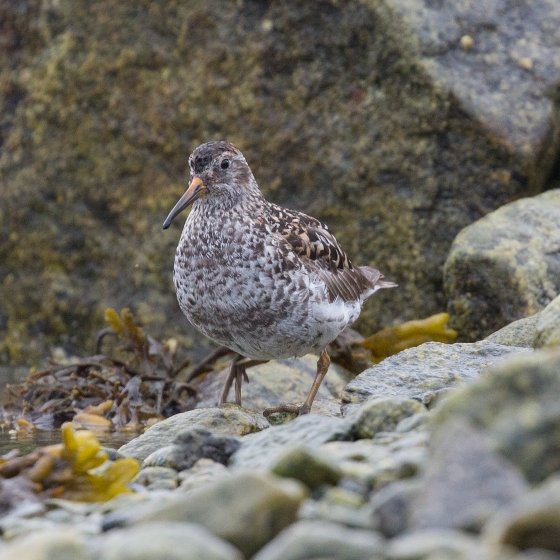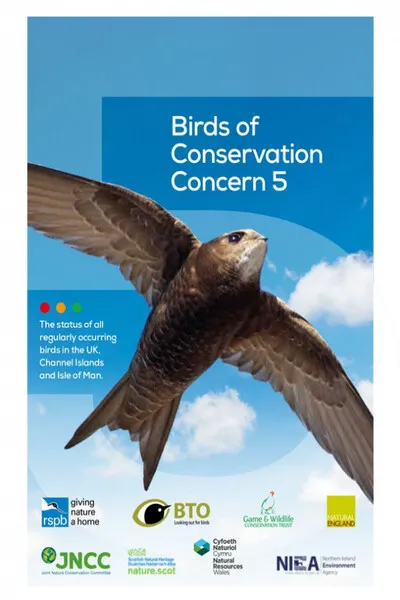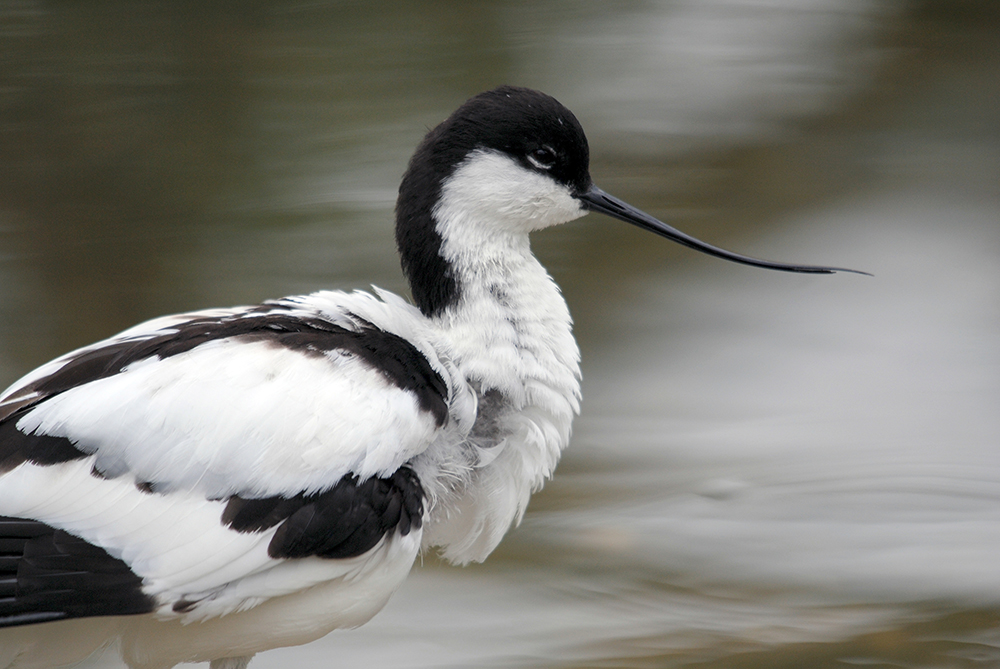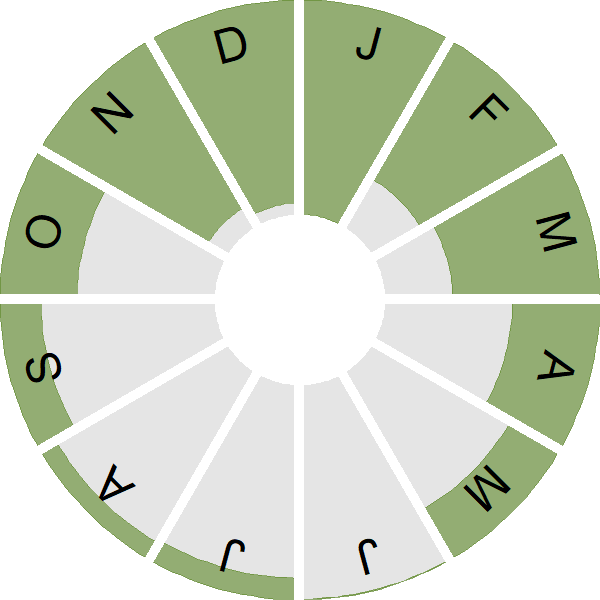Purple Sandpiper

Introduction
This hardy wader is found on exposed rocky shores in winter; only its breeding plumage is purple-tinged.
Never common as a breeding bird, with only a handful of pairs recorded in northern Scotland, the Purple Sandpiper is now a less than annual breeder. A plump, stocky wader with distinctive yellow legs it is distributed around almost all coasts in winter, only being scarce in southern and eastern England.
Ringing records show that Purple Sandpipers are remarkably faithful to wintering sites, with individuals returning to the exact same stretch of coast year after year.

Key Stats
Identification
Songs and Calls
Call:
Status and Trends
Conservation Status
Population Change
The UK plays host to wintering Purple Sandpipers from the eastern Canadian, Scandinavian and Svalbard breeding populations. It is also a very scarce breeding species, with one or two confirmed breeding records reported annually. This species is found on rocky shores in small numbers around UK coastlines, with internationally important numbers at a few sites in Scotland and north-east England, . The number of birds wintering here peaked in the mid 1980s, after which the species declined, although numbers have remained stable in recent years.
Distribution
Purple Sandpipers prefer northern, exposed, shallow rocky shores in winter. High concentrations occur along the coasts of the northern North Sea, Northern Isles and Outer Hebrides and around exposed headlands in Ireland. Elsewhere, occupied areas around Wales and southeastern and southern England hold very few birds. Purple Sandpiper is among the UK's rarest breeding species, with occasional breeding in the Scottish Highlands.
Occupied 10-km squares in UK
or view it on Bird Atlas Mapstore.
or view it on Bird Atlas Mapstore.
European Distribution Map
Distribution Change
Change in occupied 10-km squares in the UK
or view it on Bird Atlas Mapstore.
or view it on Bird Atlas Mapstore.
Seasonality
Purple Sandpipers are winter visitors; returning birds can arrive from June onwards.
Weekly pattern of occurrence
The graph shows when the species is present in the UK, with taller bars indicating a higher likelihood of encountering the species in appropriate regions and habitats.

Movement
Britain & Ireland movement
Foreign locations of birds ringed or recovered in Britain & Ireland
Dots show the foreign destinations of birds ringed in Britain & Ireland, and the origins of birds ringed overseas that were subsequently recaptured, resighted or found dead in Britain & Ireland. Dot colours indicate the time of year that the species was present at the location.
- Winter (Nov-Feb)
- Spring (Mar-Apr)
- Summer (May-Jul)
- Autumn (Aug-Oct)

European movements
EuroBirdPortal uses birdwatcher's records, such as those logged in BirdTrack to map the flows of birds as they arrive and depart Europe. See maps for this species here.
The Eurasian-African Migration Atlas shows movements of individual birds ringed or recovered in Europe. See maps for this species here.
Biology
Productivity and Nesting
Nesting timing
Egg measurements
Clutch Size
Survival and Longevity
Survival is shown as the proportion of birds surviving from one year to the next and is derived from bird ringing data. It can also be used to estimate how long birds typically live.
View number ringed each year in the Online Ringing Report.
lifespan
Survival of adults
Biometrics
Wing length and body weights are from live birds (source).
Wing length
Body weight
Ring Size
Classification, names and codes
Classification and Codes
- Order: Charadriiformes
- Family: Scolopacidae
- Scientific name: Calidris maritima
- Authority: Brünnich, 1764
- BTO 2-letter code: PS
- BTO 5-letter code: PURSA
- Euring code number: 5100
Alternate species names
- Catalan: territ fosc
- Czech: jespák morský
- Danish: Sortgrå Ryle
- Dutch: Paarse Strandloper
- Estonian: merirüdi e. meririsla
- Finnish: merisirri
- French: Bécasseau violet
- Gaelic: Luatharan-rìoghail
- German: Meerstrandläufer
- Hungarian: tengeri partfutó
- Icelandic: Sendlingur
- Irish: Gobadán Cosbhuí
- Italian: Piovanello violetto
- Latvian: juras šnibitis
- Lithuanian: jurinis begikas
- Norwegian: Fjæreplytt
- Polish: biegus morski
- Portuguese: pilrito-escuro
- Slovak: pobrežník morský
- Slovenian: morski prodnik
- Spanish: Correlimos oscuro
- Swedish: skärsnäppa
- Welsh: Pibydd Du
- English folkname(s): Grollick
Research
Causes of Change and Solutions
Causes of change
A study on the declining Purple Sandpiper population wintering in the Moray Firth in Scotland [Summers et al. 2012] concluded that this decline may be due to poor recruitment into the breeding population (possibly as a result of a decline in productivity in Norway and Canada), but may also be a response to changes in local sewage treatment systems on the Moray affecting food availability or a general reduction in the number of Purple Sandpipers wintering in Scotland. The number of Purple Sandpipers wintering in the UK may also be impacted by climate change, in particular, increasing temperatures [Rehfisch et al. 2004].
Publications (3)
The status of our bird populations: the fifth Birds of Conservation Concern in the United Kingdom, Channel Islands and Isle of Man and second IUCN Red List assessment of extinction risk for Great Britain
Author: Stanbury, A.J., Eaton, M.A., Aebischer, N.J., Balmer, D., Brown, A.F., Douse, A., Lindley, P., McCulloch, N., Noble, D.G. & Win, I.
Published: 2021
Commonly referred to as the UK Red List for birds, this is the fifth review of the status of birds in the UK, Channel Islands and Isle of Man, published in December 2021 as Birds of Conservation Concern 5 (BOCC5). This updates the last assessment in 2015. Using standardised criteria, experts from a range of bird NGOs, including BTO, assessed 245 species with breeding, passage or wintering populations in the UK and assigned each to the Red, Amber or Green Lists of conservation concern.
01.12.21
Reports Birds of Conservation Concern

Consequences of population change for local abundance and site occupancy of wintering waterbirds
Author: Méndez, V., Gill, J.A., Alves, J.A., Burton, N.H.K. & Davies, R.G.
Published: 2017
Protected sites for birds are typically designated based on the site’s importance for the species that use it. For example, sites may be selected as Special Protection Areas (under the European Union Directive on the Conservation of Wild Birds) if they support more than 1% of a given national or international population of a species or an assemblage of over 20,000 waterbirds or seabirds. However, through the impacts of changing climates, habitat loss and invasive species, the way species use sites may change. As populations increase, abundance at existing sites may go up or new sites may be colonized. Similarly, as populations decrease, abundance at occupied sites may go down, or some sites may be abandoned. Determining how bird populations are spread across protected sites, and how changes in populations may affect this, is essential to making sure that they remain protected in the future.
20.09.17
Papers

Aggressive behaviour and correlates of dominance in Purple Sandpipers Calidris maritima at a communal winter roost
Author: Burton, N.H.K. & Evans, P.R.
Published: 2001
01.01.01
Papers

